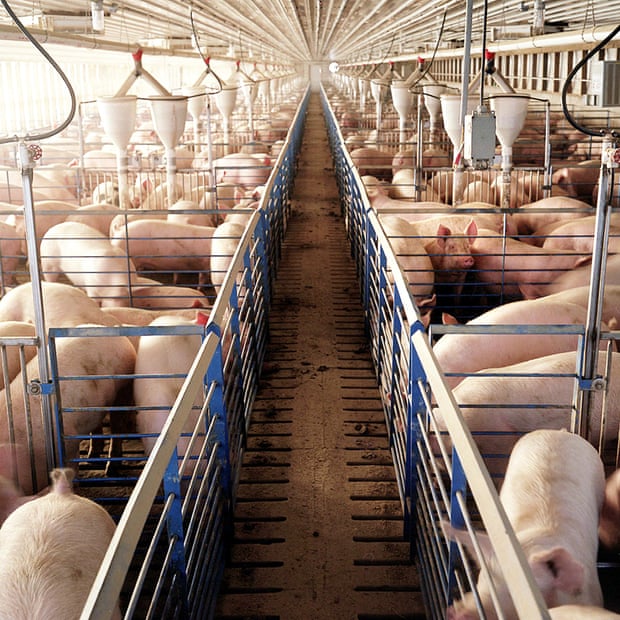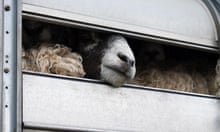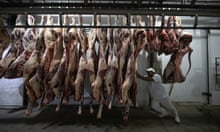Since the days of the wild west frontier, the popular image of American farming has been of cowboys rounding up steers on wide open ranches, to whoops, whips and hollers. Today, the cowboys on their ranches under wide open skies have been replaced by vast sheds, hulking over the plains, housing tens of thousands of animals each, with the noises and smells spreading far beyond their fences.
The US has led the world in large-scale farming, pioneering the use of intensive livestock rearing in hog farms, cattle sheds and sheep pens. There are now more than 50,000 facilities in the US classified as concentrated animal feeding operations (CAFOs), with another quarter of a million industrial-scale facilities below that threshold.
Around the world, developing countries in particular were quick to catch up. Intensive farming of livestock offers many advantages over traditional open ranges, not least economies of cost and scale, more efficient healthcare for the herds and flocks, and ultimately cheaper food. According to the UN, globally CAFOs account for 72% of poultry, 42% of egg, and 55% of pork production.
In 2000, there were an estimated 15 billion livestock in the world, according to the Worldwatch Institute. By last year, that had risen to about 24 billion, with the majority of eggs, chicken meat and pork produced on intensive farms.
Quick GuideMegafarms
Show

What is a mega-farm?
There is no legal definition in the UK of a mega-farm. The Environment Agency, and its regional counterparts, classify livestock farms as "intensive" if they have hold at least 40,000 poultry or 2,000 pigs or 750 breeding sows. In the US, larger concentrated animal feeding operations (CAFOs) are defined as those housing 125,000 broiler chickens, 82,000 laying hens, 2,500 pigs or 700 dairy or 1,000 beef cattle. There are now 1,099 mega-farms of this size in the UK.
Why are they controversial?
Mega-farms and intensive farms are controversial because they require keeping tens of thousands of animals in a small space, which campaigners and independent experts say can hamper their ability to express natural behaviours, such as moving naturally and nesting. The animals are often kept indoors throughout their lives, though on some farms they are allowed access to outdoor areas at least part of the time. There are also concerns that animals on mega farms may be over-medicated with antibiotics, as if one gets sick the whole herd is generally required to be treated.
Why do some people believe we need them?
Mega-farms and intensive farms take up much less space than traditional farms, and they allow animals to be kept securely, away from predators and potential carriers of disease. Their conditions are tightly controlled, allowing farmers to monitor the amount of daylight, water and feed for the animals, and if disease develops the livestock can be treated quickly.
Ranching was never an option in the UK, but most people still expect farms to consist of green fields rather than vast industrial-scale sheds. The reality is an increasing number of livestock are “zero graze”, spending all or almost all of their time indoors in large warehouse-type facilities.
As a joint investigation by the Guardian and the Bureau of Investigative Journalism revealed on Monday, at least 789 megafarms, meeting the US definition of CAFOs, now operate around the UK, with every region of the country hosting several such operations, many of them owned by foreign multinationals. These are the biggest in a wave of intensive farms that has increased by more than a quarter in six years.
With Brexit, campaigners fear the pressure from international trade may bring even more US-style practices to Britain. British farm standards have been higher than EU-wide welfare practices in the past, and now are in line with the EU, but in future there could be pressure to lower standards in order to compete with imports.
Emma Slawinski, director of campaigns at Compassion in World Farming, said the problems of mega farms around the world included over-medication, where animals are given antibiotics whether they are needed or not. “Factory-farmed animals are regularly given antibiotics in their feed or water, because of the higher risk of disease when large numbers of animals are kept in these overcrowded conditions. There is strong evidence that this overuse of antibiotics in intensive farming is contributing to antibiotic resistance in human medicine. If animals cannot remain healthy within the conditions in which they are placed, then it is time to take a closer look at our farming systems.”

The UK’s Department of Environment, Food and Rural Affairs vowed to resist any pressure to lower standards that may come from Brexit. “Leaving the EU provides us with an unprecedented opportunity to shape our farming industry so it works for the UK and helps our farmers grow more world-class food. We are determined to make a success of it, but we will not compromise on our high animal welfare or environmental standards, and we will always protect our proud and varied farming traditions.”
The government has pledged not to dilute environmental and animal welfare standards on farms, and said keeping safety and public confidence in food would be “of the highest priority”, while ensuring that reformed or reduced subsidies for agriculture provide opportunities to market high-quality produce abroad. “This should not be a race to the bottom,” Defra said.
However, it’s not just US methods that have been imported into the UK – investment has come from overseas, too. Cargill, the US food giant, is now one of the biggest players in UK farming, with a network of more than 100 independently owned farms. At its Grandstand Road plant, the company currently processes at least 1.6 million chickens a week. The company made a profit of more than £19m last year in the UK.
Moy Park, the largest employer in Northern Ireland, is owned by JBS, a Brazilian company. It has four primary production sites in the UK, as well as further processing plants and a number of allied farms. The company made an operating profit of more than £50m in 2015.
Industrial-scale farms in the UK are the mainstay of major supermarket chains and high-street food retailers. Tesco, Sainsbury’s, Morrisons, Asda and others are all supplied by companies operating CAFOs and intensive farms. For instance, poultry supplier Hook 2 Sisters supplies customers including Tesco, Morrisons, Sainsburys, M&S, and Asda from at least 37 CAFO facilities across the UK.
Pippa Woods, of the Family Farmers’ Association, said: “Local farmers contribute to the economy, the local area, the local communities. In big farms, the profit is shaved off to American companies.”
Advocates of large livestock facilities point out that they have advantages in terms of animal welfare: for instance, the warmth, humidity and levels of daylight can be centrally controlled, predators and potential disease carriers – such as badgers – are excluded, and veterinary expertise is often on-site.
The core drivers are running costs and consumption. Our appetite for chicken, in particular, appears insatiable, now accounting for more than half the meat bought in the UK. Farmers struggling with feed costs, energy prices and the pressure from big supermarket buyers have been increasingly abandoning small-scale farming.
According to Defra, there are roughly 173 million poultry being raised at a time in the UK, amounting to more than one billion birds a year. If these birds were raised according to free range standards, they would take up an area twice the size of Copenhagen; to house these birds organically would require a space the size of Anglesey.
Food prices have risen in recent years while wages have stagnated, meaning a larger proportion of the family budget is having to be spent on food, and people on low incomes face a choice between eating and other essentials such as heating and housing. In these circumstances, measures to keep food cheap have a political resonance far beyond farming communities.
With Brexit bringing further uncertainty on all fronts, the investments by multinational companies bring a source of security to the UK’s hard-pressed farmers.
Norman Lamb, the Liberal Democrat MP for North Norfolk, and former minister, said: “We need new and robust domestic regulations to meet the emerging landscape and take the place of EU legislation post-Brexit.”
But he said people’s needs and spending power must also be taken into account. “It’s easy to condemn the producers, but the vast majority of people [in the UK] eat meat. We need to have a national debate about whether we can justify the methods to deliver. I can choose between organic meat and cheap meat, but people on low incomes might struggle to make that choice within their weekly budgets.”
- Andrew Wasley is food and agriculture reporter at the Bureau of Investigative Journalism
- Madlen Davies is science and health reporter at the Bureau of Investigative Journalism
- David Child is a freelance journalist
- Fiona Harvey is environment correspondent for the Guardian











Comments (…)
Sign in or create your Guardian account to join the discussion